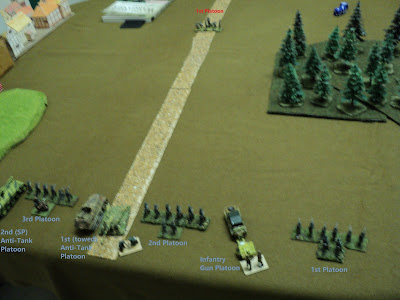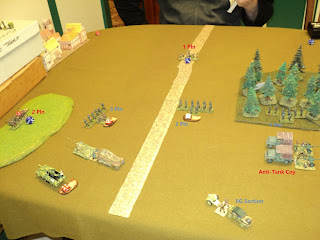 |
| The Germans hurrying westward towards their own lines see that the Russians have established a roadblock. |
 |
| Russian flank attack held by the Germans. Third Rifle Platoon has already taken a lot of stick, just 4 SPs of 15 remaining! |
 |
| Not that the Germans are getting off unscathed: the infantry have taken a hit, the AT unit 6. |
The German anti-tank guns were represented by one towed and one half-track mounted PaK40 (treated identically); the Russians had two 45mm guns towed by light trucks. The Red Army 120mm mortar was matched by the German 7.5cm light infantry gun. We neither of us had a tank to bless ourselves with.
As I had rolled first, I did suggest that Paul might like to re-roll. But he was happy enough with the status quo. I discover that Mr Thomas recommended a re-roll in the event of identical forces being generated (I ought to have looked at the time, maybe), but the result was reasonably interesting as it transpired.
 |
| Excellent German shooting. The shooting dice for the AT guns have already received the -2 adjustment for shooting at infantry. |
As the Germans stagger westwards (southwards according to book, but that is simply map orientation), the Russians race to slam shut the doors to escape. Already a Russian platoon sits astride the road west.
 |
| The sudden irruption of the Soviet AT guns deflects the infantry gun and the infantry in the woods. |
The next day I did a bit of maffs and found that under this rule set, a fire-fight between two infantry units against one infantry and two anti-tank is very nearly an even match - just the sliver of an edge in favour of the two infantry in terms of fire-power, but this being offset by the 15 extra SPs they have to eliminate. But in the German favour here was the clincher - the infantry gun: lethal against infantry.
As it turns out, the SP anti-tank's shooting does a lot of damage to the Russian 3rd Rifle Platoon (Russians in Bold; Germans in Italics). By the time the other three units join the action, the Russians on the rise are badly outmatched. Meanwhile the 2nd Platoon and 1st Platoon are fighting their own private duel. Here the Reds get the first shots, an advantage they never lose. First Platoon enters the wood in the hope of outflanking the enemy road block.
Each unit begins with 15 'strength points' (SP), reduced by one for each pip on the dice representing shooting at it. I represented this as a sequence of coloured dice, each representing 5SP in the holders illustrated (assembled from parts given me by Brian 'A Fist full of Plastic' O'Sullivan many, many moons ago). The sequence was White/Red/Blue. I place a SP holder only when a unit started taking hits (which is why you find the towed AT gun without a marker - it never took a hit). Suppose an infantry unit has already taken 1 hit. The SP indicator is a white die showing '4'. Then it takes 6 more hits, Then, having just 8 SPs remaining, the SP indicator is switched to a red die showing '3' (5+3).
Suppose next turn it takes a further 3 hits. Then the final indicator will be the blue die showing '5' for that number of SPs remaining to it.
 |
| 2 Platoon loses its battle, but their distant opponents have taken a mauling. |
I had half-expected that. The infantry gun at once switches targets to these guns, whilst at the same time the 1st Platoon is recalled and lines the eastern wood edge. Although the Russian guns inflict some damage, they are badly over-matched - and this without taking into account the superb German shooting throughout the whole action.
 |
| The Soviet AT guns under a cross fire - 9 hits on this move being enough to destroy one unit and bring the other almost to its demise as well. |
 |
| The road block is still there. A rare instance of poor shooting by the Germans |
In retrospect it is hard to determine the balance of that scenario as played with the forces allocated. German shooting was superb all night. The 'one' shown in the picture to the right for 3rd Platoon shooting was a rarity, and my AT guns seemed to shrug off their disadvantages in this type of fight. One thing for sure, the Russians could well have used their 'mortar' much earlier in the fight, perhaps substituting for one of the platoons on the hill.
Thanks, Paul, for an enjoyable evening.
Post script: I was going to include in this posting some comments on scaling WW2 miniatures games. I'll leave that for another occasion.



Hooray. I was tempted to place the mortar on the hill but thought it would die instantly. I should have really placed it as the first unit . Anyways !
ReplyDeleteI didn't really think much about how I would have played the units had I been given your situation. My suggestion with the mortar was very much in hindsight.
DeleteVery nice, I'm a big fan of One Hour Wargames, it's nice to see it on your table.
ReplyDeleteThere may be more. Some time. I have been thinking about doing one scenario with different periods. Unfortunately, the Ancient/Dark Ages/ Mediaeval periods don't fit my armies. My DBA Romans lack an enemy; and I'd have to come up with a different range of troop types to fit my 10-11th century Byzantines. For the Pike and Shot I'd probably replace the 'swordsmen' with 'commanded musketeers', as I use 30YW armies.
DeleteThere is no substitute in wargaming for a convivial opponent.
ReplyDeleteNot even solo - I agree.
Delete